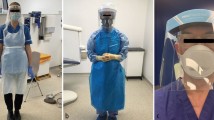Abstract
Aim This narrative review aims to report on the impacts of COVID-19 on the provision of dental education in the 67 dental schools in the United States (US). Having set the scene and current challenges, it aims to suggest some strategies to overcome the issues facing dental schools going forward.
Background In the US the Occupational Safety and Health Administration classified dentists in the very high risk category because of the potential for exposure to the virus as a result of aerosol generating procedures (AGP). In the last 20 years there have been two previous outbreaks of coronaviruses (severe acute respiratory syndrome and Middle East respiratory syndrome) which resulted in no long-term changes in the provision of dental education. The recent paper from Wuhan, China described action in the height of the infection but no sustainable actions to deliver dental education going forward.
Challenges The challenges identified include: protecting the health of students, faculty and staff; ensuring the continuity and quality of dental education; ensuring confidence in health and safety measures; and keeping up with guidance. There is some variation across the US but most schools have suspended clinical teaching and implemented stay at home policies. Others have implemented social distancing in laboratories including clinical skills. The final challenge is ensuring that students have the teaching, experience and are assessed to ensure the competency of the graduating student.
Solutions Technology in teaching and learning offers many opportunities. For didactic teaching distance learning has been implemented. There are 'off the shelf' programmes for teaching and assessment. The development of bespoke content is time consuming and one solution is for schools to share material. Although still requiring social distancing, manikins and haptics offer some opportunities for skills training. The need for excellent information sharing with faculty and students is emphasised.
Conclusion Schools should re-evaluate their policies and curricula and incorporate appropriate methods of distance learning permanently into their teaching. Students should have outreach and multi-professional support in order to allow them to assist in the community during public health crises. Finally, gaps have been identified in US dental schools preparedness for pandemics.
Similar content being viewed by others
A commentary on
Iyer P, Aziz K, Ojcius D M.
Impact of COVID19 on dental education in the United States. J Dent Educ 2020. DOI: 10.1002/jdd.12163.

GRADE rating
Commentary
Although this review is US focused the impacts on dental education in the immediate and longer term because of the COVID-19 pandemic are shared across the World.1 The introduction and background sets the scene well and the current understanding of risks associated with aerosols.2 The point that is not emphasised is that dental schools are different to primary care dental practices and non-teaching secondary care institutions, because they have large open clinics and a need for supervising dentists to move between patients. Both this review and the paper from Wuhan, China discuss strategies to deliver emergency care during the pandemic, such as patient screening, remote consultations and appropriate use of personal protective equipment (PPE).3

© Paul Biris/Getty Images Plus
However, there is no discussion of how to deliver clinical dental education in the future, particularly on open clinics, assuming there continues to be an infection risk for the foreseeable future. Fortunately infection levels among dental personnel appear currently to be relatively low probably because of the use of PPE, high volume suction etc. Even if this is the case and staff are protected, what is the risk to adjacent patients on open clinics if AGP are being produced? Currently, there is very limited evidence relating to dental aerosol and viral transmission.4 Bacterial studies suggest two meters around the chair is a safe zone.5
The review correctly identifies that although technology provides many opportunities particularly in the field of distance learning, staff and perhaps students as well will need significant professional development to utilise it effectively. Similarly, the need to utilise the most appropriate educational methodologies is well made.
The attention to student and staff wellbeing is commendable, as there will be understandable anxiety and confusion. There is therefore a need for excellent communication of roles, responsibilities, policies and support structures.
Although this review has flaws, for example its lack of focus on the future of clinical teaching, it does have many positives. The COVID-19 pandemic undoubtedly presents many challenges but also the opportunity to revolutionise dental education. As Winston Churchill is reported to have said, 'never let a good crisis go to waste'.
References
Coulthard, P. Dentistry and coronavirus (COVID-19) - moral decision-making. Br Dent J 2020; 228: 503-505.
U.S. Department of Labour. Occupational Safety and Health Administration. Guidance on preparing workplaces for COVID-19. OSHA 3,990. Available at https://www.osha.gov/Publications/OSHA3990.pdf (accessed April 2020).
Meng L, Hua F, Bian Z. Coronavirus Disease 2019 (COVID19): Emerging and Future Challenges for Dental and Oral Medicine. J Dent Res 2020; 99: 481-487.
Zemouri C, de Soet H, Crielaard W et al. A scoping review on bio-aerosols in healthcare and the dental environment. PLoS ONE 2017: 12: e0178007.
Chiramana, S, Bindu O SH, Kadiyala KK et al. Evaluation of Minimum Required Safe Distance between Two Consecutive Dental Chairs for Optimal Asepsis. J Orofac Res 2013; 3: 1215.
Author information
Authors and Affiliations
Rights and permissions
About this article
Cite this article
Deery, C. The COVID-19 pandemic: implications for dental education . Evid Based Dent 21, 46–47 (2020). https://doi.org/10.1038/s41432-020-0089-3
Published:
Issue Date:
DOI: https://doi.org/10.1038/s41432-020-0089-3
This article is cited by
-
Application of lecture-and-team-based learning in stomatology: in-class and online
BMC Medical Education (2024)
-
Assessment of the quality of root canal fillings performed on extracted teeth by undergraduate dental students in a sample from Saudi Arabia
BMC Medical Education (2024)
-
Update of students’ and lecturers’ perspectives on online learning in dental education after a five-semester experience due to the SARS-CoV-2 (COVID-19) pandemic: insights for future curriculum reform
BMC Medical Education (2023)
-
Impacts of COVID-19 on primary, secondary and tertiary education: a comprehensive review and recommendations for educational practices
Educational Research for Policy and Practice (2023)
-
Impact of COVID-19 on Malaysian dental students’ physical, mental, financial and academic concerns
BMC Oral Health (2022)



